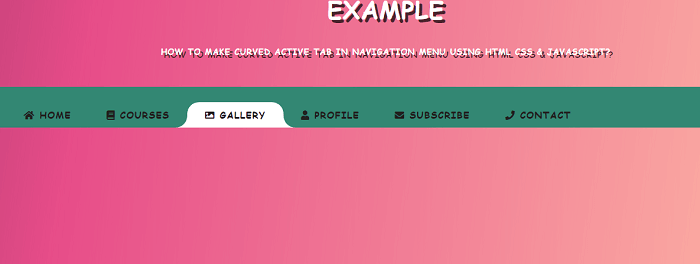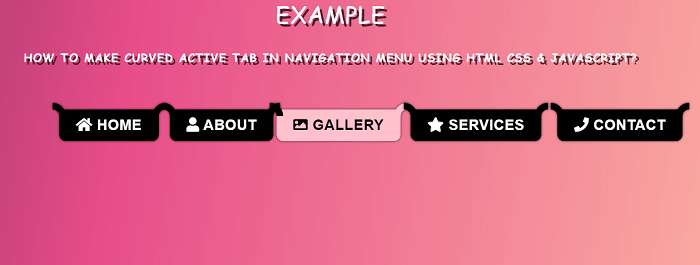如何使用HTML CSS和JavaScript制作导航菜单中的弯曲活动选项卡
在本文中,我们将学习如何使用HTML、CSS和JavaScript制作导航菜单中带有外部曲线的活动选项卡。我们使用HTML列表元素创建导航菜单,使用CSS伪元素在菜单中添加外部曲线,使用JavaScript在菜单中添加活动类。
以下是使用HTML、CSS和JavaScript制作导航菜单中的弯曲外部非活动选项卡的各种示例。
示例1
<! DOCTYPE html>
<html lang = "en">
<meta charset = "utf-8">
<meta name = "viewport" content = "width=device-width, initial-scale=1,
shrink-to-fit = no">
<head>
<title> how to make curved active tab in navigation menu using HTML, CSS & JavaScript </title>
<script src =
"https://ajax.googleapis.com/ajax/libs/jquery/3.5.1/jquery.min.js">
</script>
<link rel = "stylesheet" href =
"https://cdnjs.cloudflare.com/ajax/libs/font-awesome/5.15.4/css/all.min.css" />
<style>
body {
color: #fff;
font-family: 'Raleway';
font-size: 1.6rem;
font-weight: 700;
letter-spacing: 1px;
height: 100vh;
margin: 0;
text-transform: uppercase;
}
.gradient-background {
background: linear-gradient(100deg,#200c32,#e74d89,#febaa6);
background-size: 180% 180%;
animation: gradient-animation 9s ease infinite;
}
@keyframes gradient-animation {
0% {
background-position: 0% 50%;
}
50% {
background-position: 100% 50%;
}
100% {
background-position: 0% 50%;
}
}
.navbar {
position: fixed;
left: 0px;
top: 160px;
height: auto;
width: 100%;
background: #338773;
}
.navbar ul {
display: flex;
list-style-type: none;
margin-block-start: 1em;
margin-block-end: 1em;
margin-inline-start: 0px;
margin-inline-end: 0px;
padding-inline-start: 0px;
margin-bottom: 0px;
padding-left: 40px;
}
.navbar ul li {
display: inline;
list-style: none;
padding-left: 30px;
padding-right: 30px;
padding-top: 10px;
padding-bottom: 10px;
font-size: 1rem;
border-radius: 20px 20px 0px 0px;
position: relative;
}
.navbar ul li.active {
background: #fff;
}
.navbar ul li a {
text-decoration: none;
font-family: 'Bangers', cursive;
color: #22201f;
}
.navbar ul li.active a {
color: #22201f;
}
.navbar ul li b.left-curve {
position: absolute;
bottom: 0px;
left: -20px;
height: 100%;
width: 20px;
background: #fff;
display: none;
}
.navbar ul li b.left-curve::before {
content: " ";
top: 0;
left: 0;
position: absolute;
width: 100%;
height: 100%;
border-bottom-right-radius: 20px;
background: #338773;
}
h3 {
text-align: center;
font-weight: bold;
color: #fff;
text-transform: uppercase;
font-size: 1em;
white-space: nowrap;
font-size: 1vw;
z-index: 1000;
font-family: 'Bangers', cursive;
text-shadow: 5px 5px 0 rgba(0, 0, 0, 0.7);
@include skew(0, -6.7deg, false);
@include transition-property(font-size);
@include transition-duration(0.5s);
}
h2 {
text-align: center;
font-weight: bold;
color: #fff;
text-transform: uppercase;
font-size: 1.2em;
white-space: nowrap;
font-size: 3vw;
z-index: 1000;
font-family: 'Bangers', cursive;
text-shadow: 5px 5px 0 rgba(0, 0, 0, 0.7);
@include skew(0, -6.7deg, false);
@include transition-property(font-size);
@include transition-duration(0.5s);
}
.navbar ul li b.right-curve {
position: absolute;
right: -20px;
top: 0px;
height: 100%;
width: 20px;
background: #fff;
display: none;
}
.navbar ul li b.right-curve::before {
content: " ";
right: 0;
position: absolute;
width: 100%;
top: 0;
height: 100%;
border-bottom-left-radius: 20px;
background: #338773;
}
.navbar ul li.active b.left-curve {
display: block;
}
.navbar ul li.active b.right-curve {
display: block;
}
</style>
</head>
<body class = "gradient-background">
<h2> Example </h2>
<h3> How to make curved active tab in navigation menu using HTML CSS & JavaScript? </h3>
<br />
<br />
<div class = "navbar">
<ul>
<li class = "list-item">
<b class = "left-curve"> </b>
<b class = "right-curve"> </b>
<a>
<i class = "fa fa-home"> </i>
Home
</a>
</li>
<li class = "list-item">
<b class = "left-curve"> </b>
<b class = "right-curve"> </b>
<a>
<i class = "fa fa-book"> </i>
Courses
</a>
</li>
<li class = "list-item">
<b class = "left-curve"> </b>
<b class = "right-curve"> </b>
<a>
<i class = "fa fa-image"> </i>
Gallery
</a>
</li>
<li class = "list-item">
<b class = "left-curve"> </b>
<b class = "right-curve"> </b>
<a>
<i class = "fa fa-user"> </i>
Profile
</a>
</li>
<li class = "list-item active">
<b class = "left-curve"> </b>
<b class = "right-curve"> </b>
<a>
<i class = "fa fa-envelope"> </i>
Subscribe
</a>
</li>
<li class = "list-item active">
<b class = "left-curve"> </b>
<b class = "right-curve"> </b>
<a>
<i class = "fa fa-phone"> </i>
Contact
</a>
</li>
</ul>
</div>
</body>
<script>
(function () {("li").click(function (e) {
e.preventDefault();
("li").removeClass("active");(this).addClass("active");
});
});
</script>
</html>
说明:
在上面的示例中,我们使用HTML、CSS和JavaScript创建了一个创建外部曲线活动标签的示例。在这个示例中,我们使用了CSS伪元素的概念来制作外部曲线。
输出:
以下是这个示例的输出。

示例2
<! DOCTYPE html>
<html lang = "en">
<meta charset = "utf-8">
<meta name = "viewport" content = "width=device-width, initial-scale=1,
shrink-to-fit = no">
<head>
<title> how to make curved active tab in navigation menu using HTML, CSS & JavaScript </title>
<script src =
"https://ajax.googleapis.com/ajax/libs/jquery/3.5.1/jquery.min.js">
</script>
<link rel = "stylesheet" href =
"https://cdnjs.cloudflare.com/ajax/libs/font-awesome/5.15.4/css/all.min.css" />
<style>
body {
color: #fff;
font-family: 'Raleway';
font-size: 1.6rem;
font-weight: 700;
letter-spacing: 1px;
height: 100vh;
margin: 0;
text-transform: uppercase;
}
.gradient-background {
background: linear-gradient(100deg,#200c32,#e74d89,#febaa6);
background-size: 180% 180%;
animation: gradient-animation 9s ease infinite;
}
@keyframes gradient-animation {
0% {
background-position: 0% 50%;
}
50% {
background-position: 100% 50%;
}
100% {
background-position: 0% 50%;
}
}
.navbar {
position: fixed;
left: 0px;
top: 160px;
height: auto;
width: 100%;
background: #338773;
}
.navbar ul {
display: flex;
list-style-type: none;
margin-block-start: 1em;
margin-block-end: 1em;
margin-inline-start: 0px;
margin-inline-end: 0px;
padding-inline-start: 0px;
margin-bottom: 0px;
padding-left: 40px;
}
.navbar ul li {
display: inline;
list-style: none;
padding-left: 30px;
padding-right: 30px;
padding-top: 10px;
padding-bottom: 10px;
font-size: 1rem;
border-radius: 20px 20px 0px 0px;
position: relative;
}
.navbar ul li.active {
background: #fff;
}
.navbar ul li a {
text-decoration: none;
color: #fff;
font-family: 'Bangers', cursive;
}
.navbar ul li.active a {
color: #308d46;
}
li.active a::before {
content: " ";
left: -30px;
bottom: 0;
height: 30px;
width: 30px;
position: absolute;
background: #338773;
border-radius: 50%;
box-shadow: 15px 15px 0 #fff;
}
li.active a::after {
content: " ";
right: -30px;
bottom: 0;
height: 30px;
width: 30px;
position: absolute;
background: #338773;
border-radius: 50%;
box-shadow: -15px 15px 0 #fff;
}
h3 {
text-align: center;
font-weight: bold;
color: #fff;
text-transform: uppercase;
font-size: 0.8em;
white-space: nowrap;
z-index: 1000;
font-family: 'Bangers', cursive;
text-shadow: 1px 1px 0 rgba(0, 0, 0, 0.7);
@include skew(0, -6.7deg, false);
@include transition-property(font-size);
@include transition-duration(0.5s);
}
h2 {
text-align: center;
font-weight: bold;
color: #fff;
text-transform: uppercase;
font-size: 1.2em;
white-space: nowrap;
font-size: 3vw;
z-index: 1000;
font-family: 'Bangers', cursive;
text-shadow: 5px 5px 0 rgba(0, 0, 0, 0.7);
@include skew(0, -6.7deg, false);
@include transition-property(font-size);
@include transition-duration(0.5s);
}
</style>
</head>
<body class = "gradient-background">
<h2> Example </h2>
<h3> How to make curved active tab in navigation menu using HTML CSS & JavaScript? </h3>
<br />
<br />
<div class = "navbar">
<ul>
<li class = "list-item">
<b class = "left-curve"> </b>
<b class = "right-curve"> </b>
<a>
<i class = "fa fa-home"> </i>
Home
</a>
</li>
<li class = "list-item">
<b class = "left-curve"> </b>
<b class = "right-curve"> </b>
<a>
<i class = "fa fa-book"> </i>
Courses
</a>
</li>
<li class = "list-item">
<b class = "left-curve"> </b>
<b class = "right-curve"> </b>
<a>
<i class = "fa fa-image"> </i>
Gallery
</a>
</li>
<li class = "list-item">
<b class = "left-curve"> </b>
<b class = "right-curve"> </b>
<a>
<i class = "fa fa-user"> </i>
Profile
</a>
</li>
<li class = "list-item active">
<b class = "left-curve"> </b>
<b class = "right-curve"> </b>
<a>
<i class = "fa fa-envelope"> </i>
Subscribe
</a>
</li>
<li class = "list-item active">
<b class = "left-curve"> </b>
<b class = "right-curve"> </b>
<a>
<i class = "fa fa-phone"> </i>
Contact
</a>
</li>
</ul>
</div>
</body>
<script>
(function () {("li").click(function (e) {
e.preventDefault();
("li").removeClass("active");(this).addClass("active");
});
});
</script>
</html>
输出:
以下是该示例的输出。

示例3
<! DOCTYPE html>
<html lang = "en">
<meta charset = "utf-8">
<meta name = "viewport" content = "width=device-width, initial-scale=1,
shrink-to-fit = no">
<head>
<title> how to make curved active tab in navigation menu using HTML, CSS & JavaScript </title>
<script src =
"https://ajax.googleapis.com/ajax/libs/jquery/3.5.1/jquery.min.js">
</script>
<link rel = "stylesheet" href =
"https://cdnjs.cloudflare.com/ajax/libs/font-awesome/5.15.4/css/all.min.css" />
<style>
body {
color: #fff;
font-family: 'Raleway';
font-size: 1.6rem;
font-weight: 700;
letter-spacing: 1px;
height: 100vh;
margin: 10;
text-transform: uppercase;
}
h3 {
text-align: center;
font-weight: bold;
color: #fff;
text-transform: uppercase;
font-size: 0.8em;
white-space: nowrap;
z-index: 1000;
font-family: 'Bangers', cursive;
text-shadow: 5px 5px 0 rgba(0, 0, 0, 0.7);
@include skew(0, -6.7deg, false);
@include transition-property(font-size);
@include transition-duration(0.5s);
}
.gradient-background {
background: linear-gradient(100deg,#200c32,#e74d89,#febaa6);
background-size: 180% 180%;
animation: gradient-animation 9s ease infinite;
}
@keyframes gradient-animation {
0% {
background-position: 0% 50%;
}
50% {
background-position: 100% 50%;
}
100% {
background-position: 0% 50%;
}
}
h2 {
text-align: center;
font-weight: normal;
color: #fff;
text-transform: uppercase;
font-size: 1.2em;
white-space: nowrap;
font-size: 3vw;
z-index: 1000;
font-family: 'Bangers', cursive;
text-shadow: 5px 5px 0 rgba(0, 0, 0, 0.7);
@include skew(0, -6.7deg, false);
@include transition-property(font-size);
@include transition-duration(0.5s);
}
.button {
background-color: #000;
color: #fff;
position: relative;
width: auto;
display: block;
padding: 14px 30px;
box-sizing: border-box;
float: left;
left: 20%;
transform: translateX(-50%);
font-family: sans-serif;
border-radius: 0 0 12px 12px;
cursor: pointer;
margin-right: 24px;
-webkit-filter: drop-shadow(0px 0px 6px rgba(0, 0, 0, .7));
filter: drop-shadow(0px 0px 2px rgba(0, 0, 0, .7));
z-index: 1;
}
.button {
-webkit-transition: 0s;
transition: 0s;
}
.button:before {
-webkit-transition: 0s;
transition: 0s;
}
.button:after {
-webkit-transition: 0s;
transition: 0s;
}
.button:before, .button:after {
content: " ";
width: 24px;
height: 24px;
position: absolute;
border-radius: 50%;
z-index: -10;
pointer-events: none;
}
.button:before {
left: -36px;
top: -12px;
border-top: 12px solid #000;
border-right: 12px solid transparent;
border-left: 12px solid transparent;
border-bottom: 12px solid transparent;
border-radius: 50%;
-webkit-transform: rotate(45deg);
-moz-transform: rotate(45deg);
-o-transform: rotate(45deg);
transform: rotate(45deg);
}
.button:after {
right: -36px;
top: -12px;
border-top: 12px solid #000;
border-right: 12px solid transparent;
border-left: 12px solid transparent;
border-bottom: 12px solid transparent;
border-radius: 50%;
-webkit-transform: rotate(-45deg);
-moz-transform: rotate(-45deg);
-o-transform: rotate(-45deg);
transform: rotate(-45deg);
}
.button:hover {
background-color: pink;
color: #000;
}
.button:hover:before {
border-top: 12px solid pink;
}
.button:hover:after {
border-top: 12px solid pink;
}
</style>
</head>
<body class = "gradient-background">
<h2> Example </h2>
<h3> How to make curved active tab in navigation menu using HTML CSS & JavaScript? </h3>
<br />
<br />
<div class = "button"> <i class = "fa fa-home"> </i> Home </div>
<div class = "button"> <i class = "fa fa-user"> </i> About </div>
<div class = "button"> <i class = "fa fa-image"> </i> Gallery </div>
<div class = "button"> <i class = "fa fa-star"> </i> Services </div>
<div class = "button"> <i class = "fa fa-phone"> </i> Contact </div>
</body>
</html>
解释:
在上面的示例中,我们创建了一个使用HTML CSS创建曲线活动标签的示例。通过使用HTML按钮,我们创建了一个活动标签菜单。
输出:
以下是此示例的输出。

 极客笔记
极客笔记